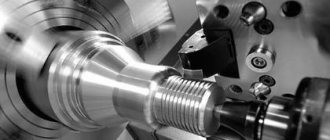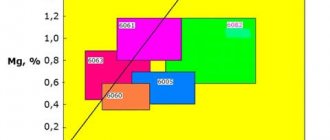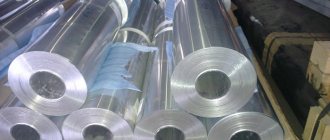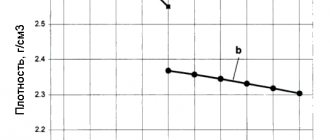Chemical composition and condition
Pure aluminum is a rather weak structural material with a tensile strength of about 90 MPa. However, when small amounts of alloying elements such as manganese, silicon, copper, magnesium or zinc are added to aluminum, as well as appropriate heat treatment and/or after cold plastic deformation, the tensile strength of aluminum - or an aluminum alloy - can reach 700 MPa.
Many aluminum alloys have wide ranges of mechanical and physical properties depending on the type of their state. They obtain these states as a result of technological processing of an aluminum product, both thermal and deformation. These wide ranges of properties of aluminum alloys provide the opportunity for a wide selection of just such an aluminum alloy that would maximize the specified properties at a minimum cost.
Buy, price from Auremo
sells products made of aluminum and its alloys, the price is optimal. We supply pipes made of aluminum alloys in metric and inch sizes. The catalog provides a wide selection of products. The price depends on the order volume and additional delivery conditions. Wholesale customers receive preferential prices. Experienced managers are in touch and will quickly help you buy the necessary products. And a large assortment will not leave you without choice. We have the best price-quality ratio. Buy aluminum today. We invite you to partner cooperation. Buy today. The best price from the supplier.
Pure aluminum
Industrial unalloyed aluminum - technically pure aluminum - contains aluminum from 99.80 to 99.00%. Unalloyed aluminum has relatively low strength and therefore has limited use as a structural material. The exception is when good electrical conductivity, ease of processing and high corrosion resistance are important. Pure aluminum does not have the ability to be thermally hardened. However, the strength properties of pure aluminum can be increased by cold hardening, that is, cold plastic deformation.
Pure aluminum has poor casting properties, so it is used mainly in the form of products that are produced by metal forming methods.
Receipt
Aluminum is in first place among metals and in third place among all elements in terms of abundance in the earth's crust. Approximately 8% of the mass of the earth's crust is this metal. Aluminum is found in the tissues of animals and plants as a trace element. In nature, it is found bound in the form of rocks and minerals. The rocky shell of the earth, which is at the base of the continents, is formed precisely by aluminosilicates and silicates.
Aluminosilicates are minerals formed as a result of volcanic processes under appropriate high temperature conditions. During the destruction of aluminosilicates of primary origin (feldspars), various secondary rocks with a higher aluminum content (alunites, kaolins, bauxites, nephelines) were formed. Aluminum is included in secondary rocks in the form of hydroxides or hydrosilicates. However, not every aluminum-containing rock can be a raw material for alumina, a product from which aluminum is produced using the electrolysis method.
Aluminum is most often obtained from bauxite. Deposits of this mineral are common in countries of the tropical and subtropical zone. In Russia, nepheline ores are also used, deposits of which are located in the Kemerovo region and on the Kola Peninsula. When extracting aluminum from nephelines, potash, soda ash, cement and fertilizers are also produced along the way.
Bauxite contains 40-60% alumina. It also contains iron oxide, titanium dioxide, and silica. The Bayer process is used to isolate pure alumina. In an autoclave, the ore is heated with caustic soda, cooled, and the “red mud” (solid sediment) is separated from the liquid. Afterwards, aluminum hydroxide is precipitated from the resulting solution and calcined to obtain pure alumina. Alumina must meet high standards for purity and particle size.
Alumina (aluminum oxide) is extracted from the mined and enriched ore. The alumina is then converted into aluminum using electrolysis. The final stage is recovery by the Hall-Heroux process. The process is as follows: during the electrolysis of an alumina solution in molten cryolite, aluminum is released. The cathode is the bottom of the electrolysis bath, and the anode is carbon bars located in cryolite. Molten aluminum is deposited under a solution of cryolite with 3-5% alumina. The process temperature rises to 950°C, which is much higher than the melting point of aluminum itself (660°C). Deep purification of aluminum is carried out by zone melting or distillation through subfluoride.
Wrought aluminum alloys
Most aluminum alloys, which are used for the manufacture of products by metal forming methods, contain no more than 7% alloying elements. By regulating the amount and type of alloying elements, the properties of aluminum are improved and its technological characteristics are increased. For example, special aluminum alloys have been developed for such specific production processes as pressing (extrusion) and forging.
Wrought aluminum alloys (as well as cast alloys) are divided into thermally hardenable and thermally non-hardening alloys. The mechanical properties of thermally non-hardening aluminum alloys are improved by cold hardening, that is, cold plastic deformation followed by partial annealing or without it. An increase in the mechanical properties of thermally hardenable alloys is achieved by hardening them at a suitable temperature and subsequent aging. For some thermally hardenable alloys, a combination of heat treatment and cold hardening is used.
The main types of semi-finished products produced from wrought aluminum alloys are:
- sheets (plates),
- foil,
- extruded profiles, pipes, rods, rods,
- cold drawn pipes;
- wire and
- forgings
Cast aluminum alloys
Aluminum alloys that are intended for casting contain one or more alloying elements in an amount of not more than 12% each. Some casting alloys are “engineered” so that they can be used in the cast state without any heat treatment. Other alloys have a chemical composition that allows them to be heat treated to improve their mechanical properties and dimensional stability. High strength along with good ductility can be obtained by choosing a suitable chemical composition and heat treatment.
Application area
This metal is actively used in the metallurgical, electrical, and mechanical industries. Let's take it in order.
As mentioned earlier, aluminum can be used to make a lightweight metal structure with a high strength coefficient. This is very beneficial in that the costs of foundations for the building, as well as the purchase of durable supports, are eliminated. Another product is very thin hot-rolled sheets, which are actively used in the chemical industry. Due to its inertness to alkalis and other chemicals, aluminum is a priority metal for room cladding.
The second area of application is electrical. It has long been known that aluminum can completely replace copper, as it is an excellent conductor of electricity. Take, for example, electronics in a car. If you replace all copper wires with aluminum, the total weight of the car will decrease by 12 kilograms. This greatly simplifies the task in mechanical engineering. By the way, this metal is often used in mechanical engineering, in the manufacture of small parts for cars and trucks. Thanks to its low weight and high strength, you can significantly reduce the overall weight of the car while maintaining all the performance characteristics.
Mechanical. Each person has his own personal gadget, electronic device or other device. But few people know that every phone contains a small amount of aluminum, which allows it to maintain the functionality of the device, as well as the battery life. Microcircuits, battery contacts - everything is made of this metal.
In addition, it is used in various mechanisms such as a crane or a heavy truck.
It is worth noting that blacksmiths recommend this metal for decorating and cladding buildings. Due to its high malleability, any product can be made from aluminum at minimal cost.
Classification of aluminum alloys
The global aluminum industry uses a classification system for aluminum alloys, which is based on the American Aluminum Association (AA) system. The same classification is used by international ISO standards and European EN standards, but in addition to the numerical designations of alloys, alphanumeric designations are also used.
All aluminum alloys are divided into wrought and cast alloys, which, in turn, are divided into various series (groups) according to the main alloying elements. Each of these groups belongs either to thermally hardenable alloys or to thermally non-hardening alloys.
Based on the classification of the American Aluminum Association, the American standard ANSI H35.1 gives designation systems for aluminum and aluminum alloys, which include:
- the method of their application (wrought, foundry and for ingots for remelting), as well as
- the condition of the alloy (with the exception of ingots for remelting, which do not have a condition).
Designations of wrought alloys
To designate wrought aluminum and wrought aluminum alloys, an international four-digit digital system is used:
Table 1
First digit
The first digit “1” indicates a series of grades of technical aluminum.
The sign by which an aluminum alloy belongs to one of the series from 2xxx to 8xxx is the alloying element with the maximum average (nominal) content. The exception is the alloys of the 6xxx series, in which the main predominant feature is the ratio of magnesium and silicon content, which are available for the formation of magnesium silicide Mg2Si.
If several alloying elements have the same maximum average content in the alloy, then the selection of the series is made in the order of the series: copper, manganese, silicon, magnesium, magnesium silicide, zinc.
Second digit
In aluminum grades of the 1xxx series, designations that have a second digit from 1 to 9 indicate special control of one or more individual impurities.
In alloys of series from 2xxx to 8xxx, the second digit in the alloy designation indicates the modification of the alloy. If the second digit is zero, then this indicates the original, base alloy. Numbers from 1 to 9 indicate, respectively, the modification of the base alloy.
Third and fourth digits
The 1xxx series includes unalloyed aluminum with a natural level of impurities. The last two digits (10xx) are used to indicate the minimum permissible aluminum content in various versions of unalloyed aluminum. They are usually called aluminum grades.
These last two digits coincide with the last digits of the minimum aluminum content, which is specified to the nearest 0.01%. For example, with an aluminum content of at least 99.80%, the aluminum grade is designated 1080.
The last two digits in the designations of alloys of the 2xxx to 8xxx series do not have any physical or chemical meaning, but simply identify the various alloys within the group.
Additional letters
Sometimes the letter A is added at the end of the four digits of the designation, which indicates the modification of the alloy. For example, alloy 6063A is a modification of alloy 6063.
Alloy condition
The full designation of a wrought aluminum alloy for finished products, in addition to the designation of the alloy, must include its condition, for example, 6063-T6.
Designations of casting alloys
The international system of designations for casting grades of aluminum and aluminum alloys is also based on four digits, but the last digit is separated from the rest by a decimal point. This system identifies aluminum grades and aluminum alloys and distinguishes between their options for finished castings and for remelting ingots.
First digit
The first digit in the designation of cast aluminum alloys indicates a series of alloys:
table 2
For casting alloys from 2хх.х to 8хх.х the corresponding series is determined by the alloying element that is present in the alloy in the maximum average concentration. If several alloying elements have the same maximum average content in an alloy, then for such an alloy the main alloying element is determined in series order: from copper (2хх.х) to tin (8хх.х).
Second and third digits
For cast aluminum of the 1xxx.x series, the second and third digits, as for wrought aluminum, indicate the purity of the metal. For alloy series 2xx.x to 9xx.x, the second and third digits identify the specific cast aluminum alloy.
Number after dot
The chemical composition of the same casting alloy, which is identified by the first three digits, has variations depending on its purpose, which are indicated by the fourth digit - the number immediately after the decimal point:
- 0 denotes casting (finished product);
- 1 denotes standard ingot;
- 2 denotes an ingot with a narrower chemical composition within the chemical composition of a standard ingot.
Additional letters
Additional variations in chemical composition, such as differences in impurity content, are indicated by capital letters before the alloy number. For example, one of the most popular alloys for gravity casting, alloy 356, has variants A356, B356 and C356. Each of these alloys has identical contents of major alloying elements, but different levels of impurities, especially iron.
Checking for density
This is exactly the case when school knowledge in physics, mathematics and chemistry will be useful in real life. Aluminum can indeed be defined by its density. How to do it:
- Take a graduated cylinder and fill it with water.
- We place a piece of the material being tested in it.
- We calculate the volume - the object will displace some of the water from the graduated cylinder, which will indicate the level on the scale when the material is removed.
- Weighs the piece being tested.
- Now we apply the formula: divide the mass by the volume.
If the result is close to 2.7 grams per milliliter, then we are definitely looking at aluminum.









